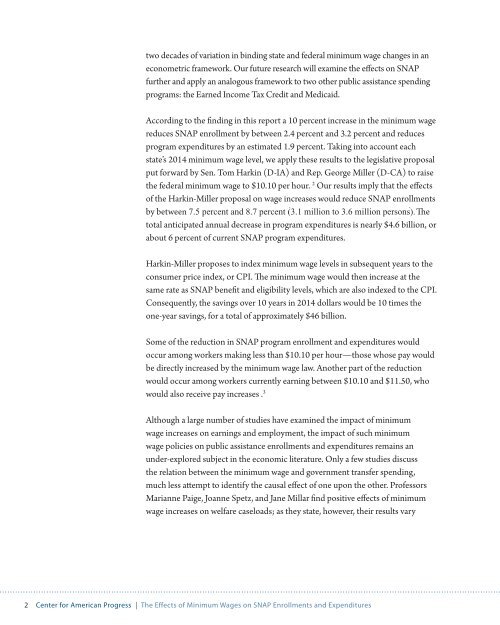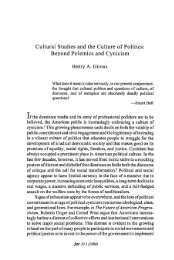effects-of-minimum-wages-on-snap
effects-of-minimum-wages-on-snap
effects-of-minimum-wages-on-snap
You also want an ePaper? Increase the reach of your titles
YUMPU automatically turns print PDFs into web optimized ePapers that Google loves.
two decades <str<strong>on</strong>g>of</str<strong>on</strong>g> variati<strong>on</strong> in binding state and federal <str<strong>on</strong>g>minimum</str<strong>on</strong>g> wage changes in an<br />
ec<strong>on</strong>ometric framework. Our future research will examine the <str<strong>on</strong>g>effects</str<strong>on</strong>g> <strong>on</strong> SNAP<br />
further and apply an analogous framework to two other public assistance spending<br />
programs: the Earned Income Tax Credit and Medicaid.<br />
According to the finding in this report a 10 percent increase in the <str<strong>on</strong>g>minimum</str<strong>on</strong>g> wage<br />
reduces SNAP enrollment by between 2.4 percent and 3.2 percent and reduces<br />
program expenditures by an estimated 1.9 percent. Taking into account each<br />
state’s 2014 <str<strong>on</strong>g>minimum</str<strong>on</strong>g> wage level, we apply these results to the legislative proposal<br />
put forward by Sen. Tom Harkin (D-IA) and Rep. George Miller (D-CA) to raise<br />
the federal <str<strong>on</strong>g>minimum</str<strong>on</strong>g> wage to $10.10 per hour.. 2 Our results imply that the <str<strong>on</strong>g>effects</str<strong>on</strong>g><br />
<str<strong>on</strong>g>of</str<strong>on</strong>g> the Harkin-Miller proposal <strong>on</strong> wage increases would reduce SNAP enrollments<br />
by between 6.5 percent and 9.2 percent (3.3 milli<strong>on</strong> to 3.8 milli<strong>on</strong> pers<strong>on</strong>s). The<br />
total anticipated annual decrease in program expenditures is nearly $4.6 billi<strong>on</strong>, or<br />
about 6 percent <str<strong>on</strong>g>of</str<strong>on</strong>g> current SNAP program expenditures.<br />
Harkin-Miller proposes to index <str<strong>on</strong>g>minimum</str<strong>on</strong>g> wage levels in subsequent years to the<br />
c<strong>on</strong>sumer price index, or CPI. The <str<strong>on</strong>g>minimum</str<strong>on</strong>g> wage would then increase at the<br />
same rate as SNAP benefit and eligibility levels, which are also indexed to the CPI.<br />
C<strong>on</strong>sequently, the savings over 10 years in 2014 dollars would be 10 times the<br />
<strong>on</strong>e-year savings, for a total <str<strong>on</strong>g>of</str<strong>on</strong>g> approximately $46 billi<strong>on</strong>.<br />
Some <str<strong>on</strong>g>of</str<strong>on</strong>g> the reducti<strong>on</strong> in SNAP program enrollment and expenditures would<br />
occur am<strong>on</strong>g workers making less than $10.10 per hour—those whose pay would<br />
be directly increased by the <str<strong>on</strong>g>minimum</str<strong>on</strong>g> wage law. Another part <str<strong>on</strong>g>of</str<strong>on</strong>g> the reducti<strong>on</strong><br />
would occur am<strong>on</strong>g workers currently earning between $10.10 and $11.50, who<br />
would also receive pay increases . 3<br />
Although a large number <str<strong>on</strong>g>of</str<strong>on</strong>g> studies have examined the impact <str<strong>on</strong>g>of</str<strong>on</strong>g> <str<strong>on</strong>g>minimum</str<strong>on</strong>g><br />
wage increases <strong>on</strong> earnings and employment, the impact <str<strong>on</strong>g>of</str<strong>on</strong>g> such <str<strong>on</strong>g>minimum</str<strong>on</strong>g><br />
wage policies <strong>on</strong> public assistance enrollments and expenditures remains an<br />
under-explored subject in the ec<strong>on</strong>omic literature. Only a few studies discuss<br />
the relati<strong>on</strong> between the <str<strong>on</strong>g>minimum</str<strong>on</strong>g> wage and government transfer spending,<br />
much less attempt to identify the causal effect <str<strong>on</strong>g>of</str<strong>on</strong>g> <strong>on</strong>e up<strong>on</strong> the other. Pr<str<strong>on</strong>g>of</str<strong>on</strong>g>essors<br />
Marianne Paige, Joanne Spetz, and Jane Millar find positive <str<strong>on</strong>g>effects</str<strong>on</strong>g> <str<strong>on</strong>g>of</str<strong>on</strong>g> <str<strong>on</strong>g>minimum</str<strong>on</strong>g><br />
wage increases <strong>on</strong> welfare caseloads; as they state, however, their results vary<br />
2 Center for American Progress | The Effects <str<strong>on</strong>g>of</str<strong>on</strong>g> Minimum Wages <strong>on</strong> SNAP Enrollments and Expenditures




